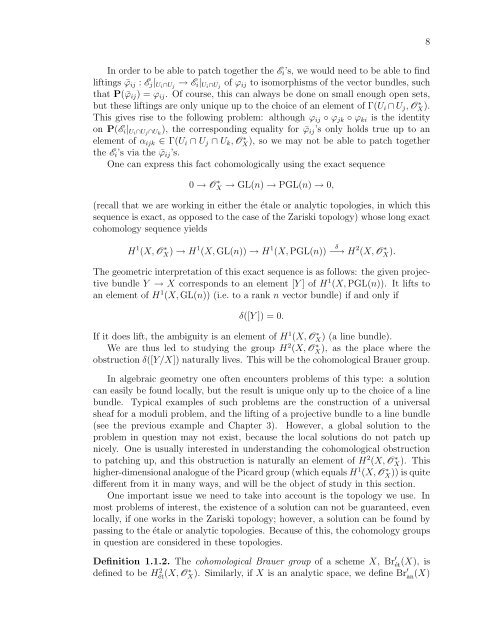derived categories of twisted sheaves on calabi-yau manifolds
derived categories of twisted sheaves on calabi-yau manifolds
derived categories of twisted sheaves on calabi-yau manifolds
You also want an ePaper? Increase the reach of your titles
YUMPU automatically turns print PDFs into web optimized ePapers that Google loves.
In order to be able to patch together the Ei’s, we would need to be able to find<br />
liftings ¯ϕij : Ej|Ui∩Uj → Ei|Ui∩Uj <str<strong>on</strong>g>of</str<strong>on</strong>g> ϕij to isomorphisms <str<strong>on</strong>g>of</str<strong>on</strong>g> the vector bundles, such<br />
that P( ¯ϕij) = ϕij. Of course, this can always be d<strong>on</strong>e <strong>on</strong> small enough open sets,<br />
but these liftings are <strong>on</strong>ly unique up to the choice <str<strong>on</strong>g>of</str<strong>on</strong>g> an element <str<strong>on</strong>g>of</str<strong>on</strong>g> Γ(Ui ∩ Uj, O ∗ X ).<br />
This gives rise to the following problem: although ϕij ◦ ϕjk ◦ ϕki is the identity<br />
<strong>on</strong> P(Ei|Ui∩Uj∩Uk ), the corresp<strong>on</strong>ding equality for ¯ϕij’s <strong>on</strong>ly holds true up to an<br />
element <str<strong>on</strong>g>of</str<strong>on</strong>g> αijk ∈ Γ(Ui ∩ Uj ∩ Uk, O∗ X ), so we may not be able to patch together<br />
the Ei’s via the ¯ϕij’s.<br />
One can express this fact cohomologically using the exact sequence<br />
0 → O ∗ X → GL(n) → PGL(n) → 0,<br />
(recall that we are working in either the étale or analytic topologies, in which this<br />
sequence is exact, as opposed to the case <str<strong>on</strong>g>of</str<strong>on</strong>g> the Zariski topology) whose l<strong>on</strong>g exact<br />
cohomology sequence yields<br />
H 1 (X, O ∗ X) → H 1 (X, GL(n)) → H 1 (X, PGL(n))<br />
δ<br />
−→ H 2 (X, O ∗ X).<br />
The geometric interpretati<strong>on</strong> <str<strong>on</strong>g>of</str<strong>on</strong>g> this exact sequence is as follows: the given projective<br />
bundle Y → X corresp<strong>on</strong>ds to an element [Y ] <str<strong>on</strong>g>of</str<strong>on</strong>g> H 1 (X, PGL(n)). It lifts to<br />
an element <str<strong>on</strong>g>of</str<strong>on</strong>g> H 1 (X, GL(n)) (i.e. to a rank n vector bundle) if and <strong>on</strong>ly if<br />
δ([Y ]) = 0.<br />
If it does lift, the ambiguity is an element <str<strong>on</strong>g>of</str<strong>on</strong>g> H1 (X, O∗ X ) (a line bundle).<br />
We are thus led to studying the group H2 (X, O∗ X ), as the place where the<br />
obstructi<strong>on</strong> δ([Y/X]) naturally lives. This will be the cohomological Brauer group.<br />
In algebraic geometry <strong>on</strong>e <str<strong>on</strong>g>of</str<strong>on</strong>g>ten encounters problems <str<strong>on</strong>g>of</str<strong>on</strong>g> this type: a soluti<strong>on</strong><br />
can easily be found locally, but the result is unique <strong>on</strong>ly up to the choice <str<strong>on</strong>g>of</str<strong>on</strong>g> a line<br />
bundle. Typical examples <str<strong>on</strong>g>of</str<strong>on</strong>g> such problems are the c<strong>on</strong>structi<strong>on</strong> <str<strong>on</strong>g>of</str<strong>on</strong>g> a universal<br />
sheaf for a moduli problem, and the lifting <str<strong>on</strong>g>of</str<strong>on</strong>g> a projective bundle to a line bundle<br />
(see the previous example and Chapter 3). However, a global soluti<strong>on</strong> to the<br />
problem in questi<strong>on</strong> may not exist, because the local soluti<strong>on</strong>s do not patch up<br />
nicely. One is usually interested in understanding the cohomological obstructi<strong>on</strong><br />
). This<br />
to patching up, and this obstructi<strong>on</strong> is naturally an element <str<strong>on</strong>g>of</str<strong>on</strong>g> H2 (X, O∗ X<br />
higher-dimensi<strong>on</strong>al analogue <str<strong>on</strong>g>of</str<strong>on</strong>g> the Picard group (which equals H1 (X, O∗ X<br />
8<br />
)) is quite<br />
different from it in many ways, and will be the object <str<strong>on</strong>g>of</str<strong>on</strong>g> study in this secti<strong>on</strong>.<br />
One important issue we need to take into account is the topology we use. In<br />
most problems <str<strong>on</strong>g>of</str<strong>on</strong>g> interest, the existence <str<strong>on</strong>g>of</str<strong>on</strong>g> a soluti<strong>on</strong> can not be guaranteed, even<br />
locally, if <strong>on</strong>e works in the Zariski topology; however, a soluti<strong>on</strong> can be found by<br />
passing to the étale or analytic topologies. Because <str<strong>on</strong>g>of</str<strong>on</strong>g> this, the cohomology groups<br />
in questi<strong>on</strong> are c<strong>on</strong>sidered in these topologies.<br />
Definiti<strong>on</strong> 1.1.2. The cohomological Brauer group <str<strong>on</strong>g>of</str<strong>on</strong>g> a scheme X, Br ′<br />
ét(X), is<br />
defined to be H2 ét (X, O∗ X ). Similarly, if X is an analytic space, we define Br′ an(X)
















